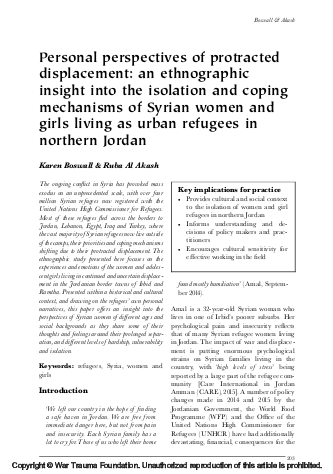
The ongoing conflict in Syria has provoked mass exodus on an unprecedented scale, with over four million Syrian refugees now registered with the United Nations High Commissioner for Refugees. Most of these refugees fled across the borders to Jordan, Lebanon, Egypt, Iraq and Turkey, where the vast majority of Syrian refugees now live outside of the camps, their priorities and coping mechanisms shifting due to their protracted displacement. The ethnographic study presented here focuses on the experiences and emotions of the women and adolescent girls living in continued and uncertain displacement in the Jordanian border towns of Irbid and Ramtha. Presented within a historical and cultural context, and drawing on the refugees’ own personal narratives, this paper offers an insight into the perspectives of Syrian women of different ages and social backgrounds as they share some of their thoughts and feelings around their prolonged separation, and different levels of hardship, vulnerability and isolation.
Links
Resource collections
- Topics
- UN Habitat - Urban Response Collection
- Urban Response - Urban Crisis Preparedness and Risk Reduction
- Urban Response Collection - Community Engagement and Social Cohesion
- Urban Response Collection - Economic Recovery
- Urban Response Collection - Environment and Climate Change
- Urban Response Collection - Housing, Land and Property
- Urban Response Collection - Urban Crisis Response, Recovery and Reconstruction
- Urban Response Collection - Urban Resilience